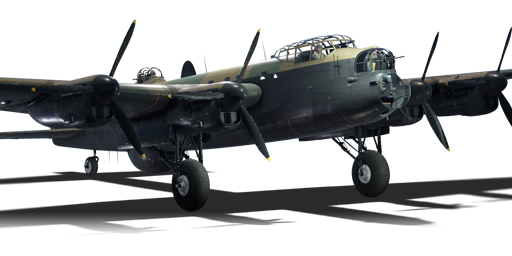



Originally developed as an improved version of the troublesome Avro Manchester medium bomber in 1940, the Avro Lancaster forwent its predecessor's unreliable pair of Rolls-Royce Vulture engines in favour of four less powerful, but much more reliable Rolls-Royce Merlin engines. With an increased wingspan, it was essentially upsized into a heavy bomber. The Lancaster's most notable feature is its long, uninterrupted bomb bay, allowing it to carry a huge variety and size of payloads, including a massive "blockbuster" high-explosive bomb. In total, 7,377 Lancasters of various models were built, being deployed extensively throughout the European theatre of World War II, in addition to spawning numerous variants such as the upsized Avro Lincoln and the maritime version, the Shackleton.
Introduced in Update 1.43, the Lancaster B Mk I is the first production variant of the Avro Lancaster. The "Lanc" lives up to its real-life reputation as the "blockbuster" in War Thunder thanks to its huge payload, both in quantity and TNT equivalent. The Lancaster can carry up to ~6,500 kg of bombs in the form of fourteen 1,000 lb bombs, or a massive 12,000 lb "Blockbuster" bomb capable of flattening an entire city block and obliterating anything within its huge explosion radius. However, being designed primarily for capacity and speed, the Lancaster is sorely lacking in survivability, with a combination of underwhelming defensive armaments and a weak airframe for its size. Therefore, it is advised to keep the bomber away from harm using its fast acceleration, good manoeuvrability for its size, and its surprisingly high shallow diving speed to evade the enemy.
flaps
flaps
flaps
brake
| Belt | Belt filling | Armor penetration (mm) at a distance: | |||||
|---|---|---|---|---|---|---|---|
| 10 m | 100 m | 500 m | 1000 m | 1500 m | 2000 m | ||
| T/AP/AP-I/Ball/Ball/I | 13 | 12 | 7 | 3 | 2 | 0 | |
| T/AP/AP/AP | 13 | 12 | 7 | 3 | 2 | 0 | |
| T/AP-I/AP-I/AP-I | 13 | 12 | 7 | 3 | 2 | 0 | |
| Belt | Belt filling | Armor penetration (mm) at a distance: | |||||
|---|---|---|---|---|---|---|---|
| 10 m | 100 m | 500 m | 1000 m | 1500 m | 2000 m | ||
| T/AP/AP-I/Ball/Ball/I | 13 | 12 | 7 | 3 | 2 | 0 | |
| T/AP/AP/AP | 13 | 12 | 7 | 3 | 2 | 0 | |
| T/AP-I/AP-I/AP-I | 13 | 12 | 7 | 3 | 2 | 0 | |
8 × M.C. 250 lb Mk.I bomb
6 × M.C. 500 lb Mk.I bomb
2 × M.C. 250 lb Mk.I bomb
6 × M.C. 1000 lb Mk.I bomb
6 × M.C. 1000 lb Mk.I bomb
2 × G.P. 250 lb Mk.IV bomb
6 × G.P. 500 lb Mk.IV bomb












Flight performance | |
|---|---|
Survivability |
|---|
Weaponry | ||
|---|---|---|